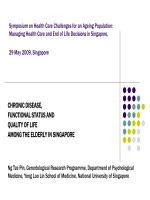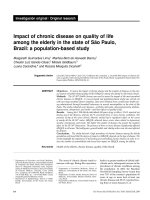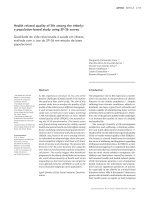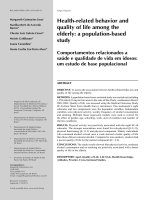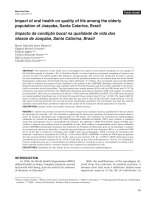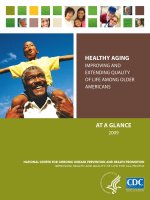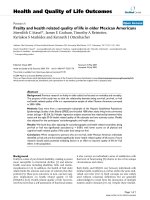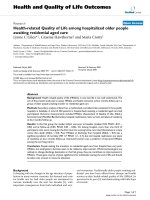Healthy aging Improving and Extending Quality of life among older americans pdf
Bạn đang xem bản rút gọn của tài liệu. Xem và tải ngay bản đầy đủ của tài liệu tại đây (4.89 MB, 4 trang )
HEALTHY AGING
ImprovIng and
ExtEndIng QualIty
of lIfE among oldEr
amErIcans
AT A GLANCE
2009
NATIONAL CENTER FOR CHRONIC DISEASE PREVENTION AND HEALTH PROMOTION
IMPROVING HEALTH AND QUALITY OF LIFE FOR ALL PEOPLE
By 2030, the number of U.S. adults aged 65 years or older will
more than double to about 71 million. e rapidly increasing
number and diversity of older Americans has far-reaching impli-
cations for the U.S. public health system and will place unprece-
dented demands on aging services and the nation’s entire health
care system.
For example, Medicare spending has grown about nine-fold in
the past 25 years, increasing from $37 billion in 1980 to $336
billion in 2005. If left unchecked, health care spending will
increase 25% by 2030, largely because of the aging population.
Chronic diseases disproportionately affect older adults and
are associated with disability, diminished quality of life, and
increased costs for health care and long-term care. Today, about
80% of older adults have at least one chronic condition, and
50% have at least two. ese conditions can cause years of pain
and loss of function. Public health efforts can help Americans
avoid preventable illness and disability as they age. Research
has shown that poor health is not an inevitable consequence of
aging. Effective public health strategies currently exist to help
older adults remain independent longer, improve their quality
of life, and potentially delay the need for long-term care.
The Health and Economic Eects of an Aging Society
2
Critical Opportunities to Improve Older Adults’ Health and Quality of Life
Our increased understanding of the critical factors involved
in protecting and promoting the health of older adults has
identified emerging public health issues that need to be
addressed, such as the following:
Promote an up-to-date measure for the use of clinical •
preventive services. Population-based data on the use
of preventive services recommended for older adults, such
as immunizations and regular health screenings, are currently
monitored individually. A composite measure
would better promote the services, improve
data collection, and more effectively guide
policy.
Address depression. • Depression affects nearly
7 million older adults, but many do not
receive treatment. Community-based strate-
gies to effectively screen and treat older adults
should be more widely disseminated.
Promote caregiving interventions. • In 2004,
about 34 million people were providing
unpaid care for adult family members, friends,
or neighbors aged 50 years or older. is num-
ber will increase dramatically as baby boomers
reach older age. A key public health goal is
to translate policies and strategies known to
improve caregiver health and well-being into
widespread practice.
Address end-of-life issues. • What most people want at the
end of their lives is well-documented—to die, as pain-free
as possible, at home with family present and to have their
wishes honored. However, many people are not allowed
“to die with dignity.” In response, public health aims to raise
awareness about the value of end-of-life planning and ensure
that individuals and their families have appropriate guidance
and information.
Heart Disease
Cancer
Stroke
Chronic Lower Respiratory Diseases
Alzheimer’s Disease
Diabetes
Influenza and Pneumonia
Unintentional Injury
All Other Causes
0 10 20 30 40
29.7
21.7
6.9
6.3
4.0
3.1
3.1
2.0
23.2
Percent of All Deaths
Causes of Death Among U.S. Adults
Aged 65 Years or Older, 2005
Source: CDC, National Center for Health Statistics, National Vital Statistics System, 2005.
3
CDC’s Healthy Aging Program conducts activities designed
to provide a comprehensive approach to helping older adults
live longer, high-quality, productive, and independent lives. e
Healthy Aging Program collaborates with other CDC programs,
such as those focused on injury prevention, disability prevention,
and adult immunizations, as well as with key external groups.
Examples of these activities include the following:
Enhance the ability of states and communities to identify •
and implement effective strategies, policies, and programs
to promote and protect the health of older adults.
CDC supports the Healthy Aging Research Network (HAN),
a consortium of nine Prevention Research Centers at academic
institutions around the country working to better understand
the determinants of healthy aging, identify interventions that
promote healthy aging, and assist in translating research into
sustainable community-based programs.
In 2008, the Healthy Aging Program sponsored “Effective
Programs to Treat Depression in Older Adults: Implementa-
tion Strategies for Community Agencies,” a symposium to
assist community-based professionals in public health, aging
services, and mental health networks in providing science-
based depression screening and management for older adults.
In 2009, a second symposium, “Promoting Environmental
and Policy Change to Support Healthy Aging,” will address
the opportunities posed by environmental and policy
strategies.
e Healthy Aging Program recently released Assuring
Healthy Caregivers, A Public Health Approach to Translating
Research into Practice: e RE-AIM Framework, to respond to
challenges in translating science-based caregiver interventions
into “real world” settings. is document helps practitioners
and researchers plan, conduct, and evaluate intervention
programs and policies that promote the health and well-
being of caregivers. It also illustrates the benefits of applying
the RE-AIM framework (Reach, Effectiveness, Adoption,
Implementation, and Maintenance) to caregiver intervention
programs, using Alabama’s REACH (Resources for Enhancing
Caregiver Health) II Caregiver Demonstration Project as an
example.
Expand efforts to integrate public health and aging •
services and enhance outreach for health promotion
and disease prevention for older adults. e Healthy
Aging Program aims to integrate public health’s expertise in
research, health tracking, and prevention programs with the
experience and reach of the nation’s aging services network.
For example, through the National Association of Chronic
Disease Directors (NACDD), CDC funds SENIOR (State-
Based Examples of Network Innovation, Opportunity,
and Replication) grants in several states (see map) to assist
selected health departments in working with aging network
colleagues to promote integrated strategies for healthy aging.
e Healthy Aging Program partnered with NACDD in
2008 to release e State of Mental Health and Aging in
America Issue Brief 1: What Do the Data Tell Us? (http://www.
chronicdisease.org/files/public/IssueBrief_eStateofMental-
HealthandAginginAmerica.pdf). is brief presents national
and state data on six indicators of mental health for older
adults. A second brief in 2009 will present interventions
addressing depression.
CDC’s Role in Promoting Healthy Aging
University of
Washington
University
of California
at Berkeley
Texas A&M
University
University of
Illinois at Chicago
University
of Pittsburgh
University of
South Carolina
University of
North Carolina
at Chapel Hill
West Virginia
University
University of
Colorado
Prevention Research Center/
Healthy Aging Research Network Site
SENIOR Grant Recipients
Selected CDC-Supported Healthy
Aging Programs, 2003–2008
e Healthy Aging Program sponsors e State of Aging
and Health in America report series and interactive Web site
( ese tools enable
public health and aging services professionals, journalists,
and researchers to evaluate key indicators of older adult
health at state and national levels. In 2009, the Web site will
be updated with the most current data.
Promote health and preserve health-related quality of life •
for older adults within health care and other systems.
Promoting the broader use of preventive services by older
adults is a key public health strategy. A recent analysis
showed that in 2004, no more than 25% of adults aged
50–64 years were up-to-date on immunizations and cancer
screenings recommended by the U.S. Preventive Services
Task Force.
In 2008, CDC collaborated with the American Medical
Association and AARP to develop Building Clinical and
Community Bridges to Promote Preventive Services for Adults
Aged 50–64 in the United States. is tool includes easily
referenced national and state data on preventive services,
effective community-based strategies, and “calls to action”
designed to ensure that adults aged 50–64 years receive
potentially lifesaving preventive services.
e Healthy Aging Program, partnered with key collabora-
tors to fund a scientific examination of the effectiveness of
community-based interventions for treating depression in
older adults. Based on these findings, e Guide to Com-
munity Preventive Services Task Force made three new
recommendations concerning mental health and older adults
().
Healthy Brain Initiative
In 2007, CDC and the Alzheimer’s Association released e
Healthy Brain Initiative: A National Public Health Road Map to
Maintaining Cognitive Health ( />map). is publication outlines specific actions for addressing
cognitive health, a major public health issue that is increasingly
affecting individuals, communities, and states. CDC supports
several projects including supporting the HAN to increase
understanding of the public’s beliefs about cognitive health
(including those of caregivers and health care providers) and
developing and implementing measures to assess and monitor
the impact of cognitive impairment to guide national and state
strategies.
Future Directions
State and local health departments, the aging services network,
and other groups that serve older adults look to CDC to provide
scientific and programmatic expertise and strategies that reduce
long-term care needs and preserve health and quality of life for
older adults. In response, CDC and its partners are working
in several areas including the following:
e Healthy Aging Program conducted research to identify •
health disparities. ey examined the health and character-
istics of American Indian and Alaska Native caregivers and
included a “call to action” in e State of Aging and Health
in America 2007 report to address health disparities among
older adults.
Working with the NACDD, the Healthy Aging Program •
examined state health departments’ needs, priorities, and
activities related to older adult health to better support state-
based efforts.
4
For more information, please contact the Centers for Disease Control and Prevention
National Center for Chronic Disease Prevention and Health Promotion
4770 Buford Highway NE, Mail Stop K–45, Atlanta, GA 30341-3717
Telephone: 770-488-5360 • Fax: 770-488-8488
E-mail: • Web: />CS123138
CDC’s Role in Promoting Healthy Aging (continued)
